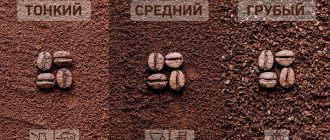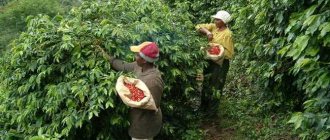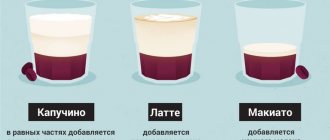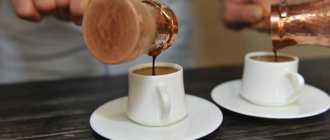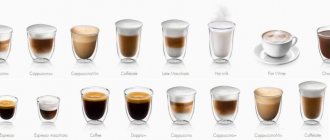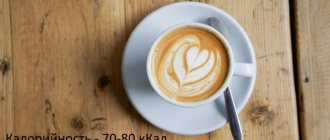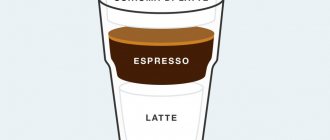Differences between latte and cappuccino recipes
To distinguish between latte and cappuccino, you need to have information about their proportional components, preparation technology and method of serving. The main difference is the proportions of the ingredients. Cappuccino is conventionally divided into three parts of equal volume: coffee, hot milk, milk froth. The proportional features of the latte are different:
- 20-23% - espresso;
- 60-66% - hot milk;
- 20-11% - milk foam.
The coffee and milkshakes in question also differ in their appearance details. Particular attention is paid to milk foam.
Cappuccino is characterized by denser and thicker foam, while latte is light and airy. The volume of foam is also different: in cappuccino it is twice as much.
These drinks can also be distinguished by the method of serving. Latte is served in a glass glass with a handle or in a regular cup. The standard latte serving size is 0.25-0.35 liters. Cappuccino is served in cups with a volume of 150-180 milliliters, and the dishes should expand towards the top. Such containers allow you to form the optimal amount of foam, which is enough for the entire volume of a hot cocktail.
Recipe
There is a widespread belief on the Internet that a latte is a coffee cocktail, and a cappuccino is coffee with milk added. If you look at it, coffee can only be called espresso; all other culinary delights based on it are called coffee drinks.
- Don't miss: Varieties of coffee drinks
Briefly, the difference between latte and cappuccino can be formulated as follows:
- Latte is milk with coffee;
- Cappuccino is coffee with milk foam.
The recipe differs in the method of mixing two liquids, the quality of the foam, and the quantity of the main ingredients.
There is also an incorrect interpretation of the preparation of drinks: to create a cappuccino, espresso is added to milk, for a latte everything happens the other way around. In fact, the classic latte recipe allows for both options, but only if the ingredients are completely mixed. Milk and coffee should create a uniform consistency in both drinks - the difference lies in the quality of the foam and the proportion of ingredients.
Classic cappuccino recipe
You can prepare cappuccino coffee yourself using the classic recipe. To do this you will need:
- 2 teaspoons of crushed coffee beans;
- 50 milliliters of water;
- 50 milliliters of milk (fat content 2.5%).
Step-by-step instruction:
- The main ingredient is prepared from crushed coffee beans and water in a Turk or coffee machine. If a Turk is used for cooking, the drink should be brought to a boil 2-3 times. This method of preparation will allow you to obtain the required strength of coffee.
- The milk is heated to 70 degrees and whipped into a thick foam.
- The foamed component is poured into a strong aromatic base in a thin stream.
- Foam is placed on top of the drink. Its volume should reach 50 milliliters.
The temperature should be between 60-70 degrees. The foam can be decorated with powdered sugar, chocolate chips, and cinnamon. It is worth considering that cappuccino foam is a good basis for drawing, so many baristas use such qualities to create mouth-watering masterpieces.
If you don’t want to draw, you can decorate the foam by sprinkling it with a little chopped chocolate.
Is it true that another difference between cappuccino is the chocolate sprinkle on the foam?
To beat or not to beat chocolate for cappuccino? This is the main question that arises when talking about making cappuccino.
If you ordered a cappuccino in Italy, there would be no chocolate on top. At the same time, if you ordered a cappuccino in Australia, Great Britain or New Zealand, you would receive enough chocolate powder to last a lifetime. The United States is not united on this issue, and whether chocolate powder is used or not depends entirely on the cafe itself.
But why such a difference of opinion? There are two reasons.
Firstly
, there is no universal standard or “rule book” for how cappuccino should be prepared.
Second
linked to local trends, once again. Like “doing what consumers expect.”
We recommend trying both the option with chocolate powder and coffee without it. You will know whether to go to the Italians or the New Zealanders!
Classic latte recipe
To prepare a latte according to the classic recipe, you need to take similar ingredients, but in different proportions. You will need:
- 150 milliliters of milk (fat content 3.2%);
- 50 milliliters of water;
- 2 teaspoons ground coffee beans;
- 2 teaspoons sugar.
Step-by-step instruction:
- Coffee is brewed in the Turk. Sugar is added to the resulting liquid.
- The milk is heated to 65 degrees and divided into 2 parts.
- Beat one milk part with a blender for 2 minutes until a stable foam forms.
- Espresso is poured into a glass with a layer of milk. Afterwards the foam is laid.
Sugar should only be added during the brewing stage of the coffee base. Its amount can be reduced based on your own taste preferences.
Interesting fact about latte drinkers
Calling people derogatory "latte drunks" has become a common political ploy in Western cultures. The popularity of espresso in major cities, especially among wealthier urban populations, leads some to consider drinking it an elitist behavior.
In the United States, conservative political commentators are known to refer to their opponents as "latte-drinking liberal elites." In Canadian politics, drinking a latte is the antithesis of the Tim Horton's coffee drinker, who is considered representative of the average Canadian.
In Scandinavian politics, the term "latte segment" is used to describe elite voters.
Now we know everything about you, latte drunkard - a product of the destructive elite!
Comparative characteristics of latte macchiato and cappuccino
The main difference between latte makiato and cappuccino is the appearance of the drinks. Latte macchiato is a three-layer coffee served in a transparent glass with a handle. Cappuccino has a homogeneous structure, achieved by mixing the coffee and milk layers. The makiato preparation technology is also different:
- Frothed milk is poured into a glass.
- After the main milk mass is separated from the foam, a portion of coffee is poured into it. The liquid should be added clearly in the center in a thin stream.
- If the technology is followed, the macchiato will acquire a three-layer structure.
This type of latte and cappuccino also have external differences in foam. A speck forms in the center of the macchiato, which is how it gets its name.
Where do these types of coffee come from?
The terms caffè and latte were first used in 1847 and later appeared in William Dean Howells' essay "Italian Travels" in 1867.
pixabay.com
Latte originally means milk in Italian, and the coffee version of the drink is an American invention. Caffè latte originated at Caffè Mediterraneum, a cafe in Berkeley, California, and was first prepared in its current form by Lino Mejorin. He added more milk to this strong cappuccino and called this new drink "caffè latte."
Cappuccino in commercial form was introduced in the early 20th century when patented espresso machines were introduced by Luigi Bezzera of Milan in 1901. These machines made cappuccino very popular among cafes and restaurants, and the current version was developed in the 1950s.
Difference with raff coffee
Another type of coffee is raf. It is made from cream, brewed coffee and vanilla sugar. The main difference between raff and the cocktails discussed above is that it is prepared from other ingredients. They also differ in volume. Rough is served in a large cup, like a latte.
Another distinctive feature of raf is the method of preparation. All ingredients are mixed together and only then beaten. In this case, the foam turns out thin, light, and disappears quickly. In other hot cocktails, milk foam is whipped separately until thick, which allows it to be preserved for up to 10-12 minutes.
It would seem so similar... but so different.
Still from the film “The Taming of the Shrew”
Millions of people order a cup of latte or cappuccino every day. A slightly smaller number of people in their lives order either a latte or a cappuccino, because in general the choice, as a rule, falls on only one. And even fewer (of those who drink both drinks) think about their difference at least once in their lives. Once and for all, we put an end to this issue and tell you how a latte differs from a cappuccino and vice versa.
Differences from Americano
Another popular drink is Americano. It is espresso diluted with hot water. Due to this method of preparation, the taste of the main component is softened, and the coffee itself becomes less strong. Americano differs from latte and cappuccino in that it is prepared without adding milk. Another difference is that it is served in a smaller cup. A standard serving of Americano is 120-180 milliliters.
It is quite easy to distinguish latte from cappuccino and other types of coffee. To do this, first of all you should pay attention to the appearance of the brought product. Milk for cappuccino is whipped so that the foam is dense and thick, and for latte – airy and light. The latter is served in Irish glasses with a handle made of heat-resistant glass. The volume of such glasses can vary from 240 to 360 milliliters. Cappuccino is served in cups with a volume of 150-180 milliliters.
You can also tell them apart by taste. Latte and its varieties have a distinct milky taste. There is 3 times more milk in a latte.
Cappuccino is characterized by a distinct coffee taste. Raf - milky taste with notes of vanilla.
What is better is up to everyone to decide, depending on their preferences. The qualities of each cocktail will vary due to the different proportions of coffee and milk used. If a person likes a richer taste, he should pay attention to cappuccino. If he likes milky notes, go for latte or its variety. Espresso or Americano should be chosen in cases where there is not enough tartness and an invigorating effect.
Composition of drinks
Cappuccino is espresso, milk and airy milk foam (ratio 1:1:1). Depending on the preparation method, a dry and dense or elastic and glossy “cap” is created on the surface of the coffee. An indicative test will tell you about the quality of the foam: adding sugar to the drink will not change its structure.
The only correct ratio of espresso, milk and milk froth for a latte is 1:2:1 - changes to the classic formula will give a completely different taste. Experienced baristas say that the height of the foam should not exceed 2 cm - the rest of the volume is occupied by the homogeneous structure of coffee with milk. The last component is not whipped to a thick foam, but is heated with constant stirring to 60°C.
The third difference is in the fortress
Due to the use of equal proportions of coffee, the strength of the drinks is absolutely the same. Only in a latte the bitterness of coffee is offset by the taste of milk. Also, the volume of the latter is larger due to the 300 ml serving glass.
What tastes better: cappuccino or latte?
Everyone has their own taste. If you need to cheer yourself up before a long day, it is better to pay attention to the rich taste of cappuccino. If your goal is to enjoy the aftertaste, you need to choose a latte.
Alternative methods of brewing coffee
Purover
youtube.com
Pour over is a brewing method in which hot water passes through ground coffee placed in a special funnel with a paper filter. In this case, the strength of the drink can be adjusted by reducing or increasing the amount of ground coffee used. This method is also called Hario or V60 (Hario V60 is a device for brewing coffee using the pour-over method).
French press
squarespace.com
French press is the name of a device for making coffee, as well as the method of preparing coffee by infusing and squeezing. It is believed that the French press allows you to reveal the true taste and aroma of exquisite coffee varieties.
Clever and Bonavita
1 / 0
Funnel Clever. giveawayservice.com
2 / 0
Funnel Bonavita. picstopin.com
Brewing in such funnels is similar to the pour-over method, only instead of the usual Hario V60 pour-over, other devices are used. After brewing the coffee, the bottom valve of the funnel opens, the coffee drains through the filter into the cup and no longer comes into contact with water. The taste of the drink is cleaner and less dusty.
Kalita
coffeenow.ph
The flat bottom with three holes of this funnel promotes more uniform extraction. Due to the holes, the water lingers a little in the funnel and additionally brews the coffee, which contributes to the richness of the taste.
Aeropress
seaislandcoffee.com
AeroPress received the name “home espresso” for its operating principle, which is similar to preparing espresso in a coffee machine. A drink prepared in an AeroPress turns out a little cloudy, but the taste is rich and dense.
Siphon
Hot water in the siphon passes through the coffee under pressure. The drink prepared in this way is visually pure and tea-like, but at the same time retains all its inherent shades of taste and aroma.
Flat White
The foam is clearly visible here, and the red tint is due to the reflection of light from my jacket. After all, the foam here is white. As in the drinks above, the flat white contains espresso and milk, but the foam has a minimum of 0.5 cm .
There is a higher concentration of coffee here. For example, 2 servings of espresso are added to a 200 ml glass, 3 to 300 ml, and 4 to 400 ml.
To make a reverse heart, first pour milk into a glass, then coffee and, without stirring, milk again
The milk is kept under the steam wand for a short time, so the foam will be the thinnest.
Almost its entire volume is poured into the glass at once, then espresso is added, and at the end milk is added to create a pattern. Thanks to this, the surface remains white and almost smooth.
This is where you will taste the coffee the most and the caffeine hit will be the most powerful.
Varieties of espresso
Dense foam is a sign of high-quality espresso.
Espresso doppio is a double strength espresso, 15 g is used to prepare it. ground coffee per 30 ml of water per serving.
Espresso Lungo is a less strong drink and requires 4 grams to prepare it. ground coffee per standard volume of water. You cannot dilute regular espresso with water to obtain lungo espresso - the result will not be lungo coffee, but Americano.
Espresso coretto is espresso in which a few drops of any alcoholic drink (cognac, rum, amaretto, etc.) are dissolved.
"Coretto" means "seasoned" in Italian. Espresso Romano is a standard espresso served with a squeeze of lemon.
Espresso macchiato is espresso to which a drop (about 15 ml) of whipped cream has been added. The cream spreads over its surface and creates a light marbled pattern. "Macchiato" means "marble" in Italian.
Espresso con panna is a Viennese coffee, a standard shot of espresso served with a large dollop of whipped cream.
The nutritional value
Cappuccinos, macchiatos, and lattes contain different amounts of milk and foam, which may slightly change their nutrient profiles.
Their nutrient content is also affected by the type of milk used, as well as added sugar or sweeteners.
Lattes contain the most milk and are higher in calories, fat and protein.
Cappuccino contains slightly less milk, but still provides the body with enough calories, protein and fat in each serving.
On the other hand, a macchiato contains only a little milk and significantly less calories, fat and protein.
Here is a comparison of three drinks (, ,):
| Drink type | Calories | Squirrels | Total fat | Carbohydrates |
| Latte (475 ml) | 206 kcal | 13 grams | 8 grams | 20.5 grams |
| Cappuccino (475 ml) | 130 kcal | 8 grams | 5 grams | 13 grams |
| Macchiato (60 ml) | 13 kcal | 0.7 grams | 0.5 grams | 1.6 grams |
Summary:
Lattes, cappuccinos, and macchiatos contain varying amounts of calories, carbohydrates, protein, and fat.
Tips for use
Cappuccino should be drunk from glasses that widen at the top. This ensures the simultaneous consumption of milk froth with a delicate taste, and bitterness with a slight sourness from coffee. To fully develop the taste, it is better to drink it without sugar.
Lattes can be drunk the same way as other cocktails - through a straw.
They seem to be almost identical both in composition and in external similarity, but still cappuccino and latte are very different. In order not to spoil your impression and choose a cocktail that is more suitable for yourself, when preparing it you need to use only high-quality products.
Espresso based
Espresso is made from fresh beans, which are ground in the machine in the photo above. This is a concentrated portion of coffee with a volume of 35 ml , obtained under water pressure with a pressure of 9 atmospheres.
Sometimes the drink is ordered separately to drink quickly and get a sharp boost in energy.
Its taste is influenced not only by the type of grain and its roasting. It turns out that at the grinding stage, the temperature and humidity in the room, as well as the grind size, are important.
iPhone 12 Pro Max pulled out coffee texture even at 3.5x zoom in low light conditions
It is better not to keep whole coffee in the transparent drum of the machine for more than a day. It begins to lose its properties due to contact with air.
That's why they don't like pre-ground coffee. When transported or stored in an open package, the taste quickly disappears.
On average, coffee beans consist of 50% cellulose, and during cooking they release from 18% to 22% of the remaining substances. If there are fewer of them, it will be fresh, and if there are more, it will become bitter.
Therefore, the powder cannot be used a second time after brewing. Although it looks almost like regular ground grain, it is actually just brown cellulose that has already given up all its flavor.

